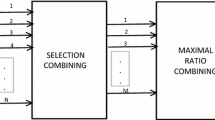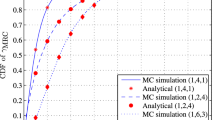Abstract
Wireless channels exhibit time, frequency, and spatial correlation. Models in literature that study four-branch diversity receivers make assumptions such as independence, constant correlation, exponential correlation, or some other kind between received signals at each antenna. However, these models are not accurate in many scenarios. Addressing this issue, we provide novel results for the moments, moment-generating function, probability density function, and cumulative distribution function of the quadrivariate Rayleigh distribution with an arbitrary correlation model. To the best of our knowledge, our model is the most comprehensive and the only one that can incorporate the 3GPP suggested spatial correlation structure. We use our new results to derive an analytical expression for the moments of the output signal-to-noise ratio of the four-branch equal gain combining receiver and the four-branch maximal ratio combining receiver. We provide original insight about their output signal-to-noise ratio distributions through their higher order moments in different scenarios. Our expressions are valid for all moments.






Similar content being viewed by others
Notes
It is not in the scope of this paper to attempt to approximate the CDF of the output SNR of the investigated diversity receivers.
Abbreviations
- \(d_{\min \limits }\) :
-
Distance between closest pair of antennas
- Dk(⋅):
-
Parabolic cylinder function
- E[ ⋅ ]:
-
Expectation operator
- fX(x):
-
Probability density function of X
- FX(x):
-
Cumulative distribution function of X
- Ik(⋅):
-
k th order modified Bessel function of the first kind
- Jk(⋅):
-
k th order Bessel function of the first kind
- MX(s):
-
Moment-generating function of X
- N o :
-
Additive white Gaussian noise power spectral density at each branch
- P o u t :
-
Outage probability
- r :
-
Rayleigh random variable
- (⋅)T :
-
Transpose operator
- z :
-
Zero-mean Gaussian random variable
- \(\overline {\boldsymbol {Z}}\) :
-
Row vector of Gaussian random variables
- γ k :
-
Instantaneous SNR at the k th branch
- \(\overline {\gamma }_{k},\overline {\gamma }\) :
-
Average SNR at the k th branch
- γ th :
-
Threshold SNR for outage probability
- γ(⋅):
-
Lower incomplete gamma function
- Γ(⋅):
-
Gamma function
- ζ :
-
Variance of Gaussian random variables
- κ :
-
Kurtosis coefficient of output SNR
- λ :
-
Wavelength
- μ :
-
Mean of power azimuth spectrum
- ρ |i−j| :
-
Correlation coefficient between i th and j th Gaussian random variable
- σ :
-
Standard deviation of output SNR
- ϕ :
-
Conditional covariance between Gaussian random variables
- Φ :
-
Inverse covariance matrix of Gaussian random variables
- Ψ :
-
Covariance matrix of Gaussian random variables
References
Jakes WC, Cox DC (1994) Microwave mobile communications, Wiley-IEEE Press, New York
Li J, Zhang EY (2005) IEEE International Symposium on Communications and Information Technology. ISCIT 1:222
3GPP-3GPP2 (2003). Spatial channel model text description
Mnatsakanov RM, Hakobyan AS (2009) Lecture Notes-Monograph Series 57:252. http://www.jstor.org/stable/30250044
N. Networks (2015) Lte networks for public safety services. Tech rep, Nokia Solutions and Networks
Rice SO (1944) The Bell System Technical Journal 23(3):282. https://doi.org/10.1002/j.1538-7305.1944.tb00874.x
Tan CC, Beaulieu NC (1997) IEEE Trans Commun 45(10):1159. https://doi.org/10.1109/26.634675
Miller KS (1969) SIAM Review 11(4):544
Blumenson LE, Miller KS (1963) The Annals of Mathematical Statistics 34(3):903. http://www.jstor.org/stable/2238472
Chen Y, Tellambura C (2005) IEEE Trans Commun 53(12):2092. https://doi.org/10.1109/TCOMM.2005.860059
Nadarajah S, Kotz S (2007) IEEE Trans Commun 55(3):392. https://doi.org/10.1109/TCOMM.2007.892438
Le KN (2016) IEEE Commun Lett 20(9):1717. https://doi.org/10.1109/LCOMM.2016.2582823
Mallik RK (2003) IEEE Trans Inf Theory 49(6):1499. https://doi.org/10.1109/TIT.2003.811910
Beaulieu NC, Hemachandra KT (2011) IEEE Transactions on Information Theory 57(12):8072. https://doi.org/10.1109/TIT.2011.2170133
Beaulieu NC, Zhang Y (2017) IEEE Trans Commun 65(9):3976. https://doi.org/10.1109/TCOMM.2017.2709307
Middleton D (1960) An introduction to statistical communication theory, vol 960. McGraw-Hill, New York
Abramowitz M, Stegun IA (1964) Handbook of mathematical functions: with formulas, graphs, and mathematical tables, vol 55. National Institute of Standards and Technology (NIST), Gaithersburg
Gradshteyn IS, Ryzhik IM (2007) Table of integrals, series, and products, 7th edn. Academic, New York
Goldsmith A (2005) Wireless communications. Cambridge University Press, Cambridge
Lawson JL, Uhlenbeck GE (1950) Radiation Laboratory Series. 24
Author information
Authors and Affiliations
Corresponding author
Additional information
Publisher’s note
Springer Nature remains neutral with regard to jurisdictional claims in published maps and institutional affiliations.
This work was supported in part by the University of Missouri - Kansas City, School of Graduate Studies.
Appendices
Appendix A: Derivation of the PDF of the quadrivariate Rayleigh distribution
The joint PDF of zero-mean equal variance (ζ) Gaussian RVs \(\boldsymbol {Z} = \{{z}_{{I}_{1}}, {z}_{{Q}_{1}}, \dots , {z}_{{I}_{4}}, {z}_{{Q}_{4}}\}\) is given by (1) where (⋅)T denotes the transpose operator, \(\overline { \boldsymbol {Z}} = [{z}_{{I}_{1}}, {z}_{{Q}_{1}}, \dots , {z}_{{I}_{4}}, {z}_{{Q}_{4}}]^{T}\) and Ψ is a positive definite covariance matrix [16] (7.18a). We define \( \rho _{|i-j|}={E[{z}_{{I}_{i}}{z}_{{I}_{j}}]}/{\zeta }={E[{z}_{{Q}_{i}}{z}_{{Q}_{j}}]}/{\zeta }\) for \(i,j \in \{1,\dots ,4\}\). Substituting \({z}_{{I}_{k}}=r_{k} \cos \limits (\theta _{k})\), \({z}_{{Q}_{k}}=r_{k}\sin \limits (\theta _{k})\) yields the joint PDF of R = {r1, r2, r3, r4} and Θ = {θ1, θ2, θ3, θ4}:
We substitute \(e^{A\cos \limits (x)}=I_{0}(A)+2{\sum }_{a=1}^{\infty }I_{a}(A)\cos \limits (ax)\) as given in [17] (9.6.34) and integrate over phases, Θ. After algebraic manipulation we reach (4).
Appendix B: Derivation of the CDF of the quadrivariate Rayleigh distribution
We expand \(I_{l}(x)=\left (\tfrac {x}{2}\right )^{l} {\sum }_{k=0}^{\infty }\tfrac {\left (x^{2}/4\right )^{k}}{k! {\Gamma }(l+k+1)}\) as given in [17] (9.6.10) where Γ(⋅) denotes the gamma function and integrate (4). We start with r1:
We make substitution \(u=\tfrac {\phi _{1}{r_{1}^{2}}}{2\zeta }\).
where ν1 = |l| + |j| + |j + l| + 2b + 2h + 2f. We rely on the integral representation of lower incomplete gamma function as given in [17] (6.5.2) reaching the final expression in (42). We repeat the same integration process for r2, r3, r4. After algebraic manipulation we reach (5).
Appendix C: Derivation of the MGF of the quadrivariate Rayleigh distribution
By definition,
Using (4) and substituting modified Bessel function of the first kind with its infinite series representation, as given in [17] (9.6.10), we proceed:
where ν1 = |l| + |j| + |j + l| + 2b + 2h + 2f and Dk(⋅) denotes the parabolic cylinder function [18] (9.240). We rely on the equation given in [18] (3.462.1) reaching the final expression in (44). We repeat the same integration process for r2, r3, r4. After algebraic manipulation we reach (7).
Rights and permissions
About this article
Cite this article
Tekinay, M., Beard, C. Moments of the quadrivariate Rayleigh distribution with applications for diversity receivers. Ann. Telecommun. 75, 447–459 (2020). https://doi.org/10.1007/s12243-020-00755-6
Received:
Accepted:
Published:
Issue Date:
DOI: https://doi.org/10.1007/s12243-020-00755-6




